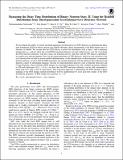Measuring the Delay Time Distribution of Binary Neutron Stars. II. Using the Redshift Distribution from Third-generation Gravitational-wave Detectors Network
Author(s)
Safarzadeh, Mohammadtaher; Berger, Edo; Ng, Ken K. Y.; Chen, Hsin-Yu; Vitale, Salvatore; Whittle, Christopher Mark; Scannapieco, Evan; ... Show more Show less
DownloadPublished version (2.086Mb)
Publisher Policy
Publisher Policy
Article is made available in accordance with the publisher's policy and may be subject to US copyright law. Please refer to the publisher's site for terms of use.
Terms of use
Metadata
Show full item recordAbstract
© 2019. The American Astronomical Society. All rights reserved. We investigate the ability of current and third-generation gravitational wave (GW) detectors to determine the delay time distribution (DTD) of binary neutron stars (BNSs) through a direct measurement of the BNS merger rate as a function of redshift. We assume that the DTD follows a power-law distribution with a slope Γ and a minimum merger time t min, and also allow the overall BNS formation efficiency per unit stellar mass to vary. By convolving the DTD and mass efficiency with the cosmic star formation history, and then with the GW detector capabilities, we explore two relevant regimes. First, for the current generation of GW detectors, which are only sensitive to the local universe but can lead to precise redshift determinations via the identification of electromagnetic counterparts and host galaxies, we show that the DTD parameters are strongly degenerate with the unknown mass efficiency and therefore cannot be determined uniquely. Second, for third-generation detectors such as Einstein Telescope and Cosmic Explorer, which will detect BNS mergers at cosmological distances but with a redshift uncertainty inherent to GW-only detections (δ(z)/z ≈ 0.1z), we show that the DTD and mass efficiency can be well constrained to better than 10% with a year of observations. This long-term approach to determining the DTD through a direct mapping of the BNS merger redshift distribution will be supplemented by more near-term studies of the DTD through the properties of BNS merger host galaxies at z ≈ 0.
Date issued
2019-06Department
LIGO (Observatory : Massachusetts Institute of Technology); MIT Kavli Institute for Astrophysics and Space Research; Massachusetts Institute of Technology. Department of PhysicsJournal
Astrophysical Journal Letters
Publisher
American Astronomical Society